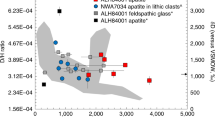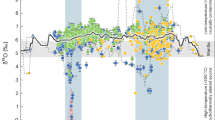Abstract
ANCIENT fluvial networks on the surface of Mars suggest that it was warm and wet over three billion years ago. Surface features resembling massive outflow channels provide evidence that, even more recently, the martian crust contained the equivalent of a planet-wide reservoir of water several hundred metres deep1,2. But arguments based on the isotopic fractionation3,4 and present-day escape rate of hydrogen in the martian atmosphere require only 0.5 metres of crustal water today and about six metres in the past5. An additional constraint on the evolution of the isotopic composition of martian water has recently been obtained6 from measurements of the deuterium to hydrogen ratio of hydrous minerals in the SNC meteorites—meteorites that almost certainly originated on Mars. Here I show that these new data require that the modern crustal reservoirs of martian water must be quite large, at least several metres in global-equivalent depth. The deuterium enrichment of the present martian atmosphere then implies that the reservoir of crustal water on ancient Mars was several hundred metres deep, consistent with the geological evidence3,4.
This is a preview of subscription content, access via your institution
Access options
Subscribe to this journal
Receive 51 print issues and online access
$199.00 per year
only $3.90 per issue
Buy this article
- Purchase on Springer Link
- Instant access to full article PDF
Prices may be subject to local taxes which are calculated during checkout
Similar content being viewed by others
References
Carr, M. H. J. geophys. Res. 84, 2995–3007 (1979).
Carr, M. H. Nature 326, 30–34 (1987).
Owen, T. et al. Science 240, 1767–1770 (1988).
Bjoraker, G. L., Mumma, M. J. & Larson, H. P. Bull. Am. Astr. Soc. (abstr.) 21, 990 (1989).
Yung, Y. et al. Icarus 76, 146–159 (1988).
Watson, L. L. et al. Science 265, 86–90 (1994).
Krasnopolsky, V. A. Icarus 101, 33–41 (1993).
Jakosky, B. M. J. geophys. Res. 95, 1475–1480 (1990).
McElroy, M. B. & Donahue, T. M. Science 177, 986–988 (1972).
Liu, S. C. & Donahue, T. M. Icarus 28, 231–245 (1976).
Fox, J. L. Geophys. Res. Lett. 20, 1747–1750 (1993).
Luhmann, J. G., Johnson, R. E. & Zhang, M. H. G. Geophys. Res. Lett. 19, 2151–2154 (1992).
Jakosky, B. M. et al. Icarus 111, 271–288 (1994).
Hunten, D. M. J. atmos. Sci. 30, 736–732 (1973).
Hunten, D. M. J. atmos. Sci. 30, 1481–1494 (1973).
Atreya, S. K. & Gu, Z. G. J. geophys. Res. 99, 13133–13145 (1994).
Nair, H. et al. Icarus 111, 124–150 (1994).
Carr, M. H. Icarus 87, 210–227 (1990).
Kasting, J. F. Icarus 94, 1–13 (1991).
Author information
Authors and Affiliations
Rights and permissions
About this article
Cite this article
Donahue, T. Evolution of water reservoirs on Mars from D/H ratios in the atmosphere and crust. Nature 374, 432–434 (1995). https://doi.org/10.1038/374432a0
Received:
Accepted:
Issue Date:
DOI: https://doi.org/10.1038/374432a0
Comments
By submitting a comment you agree to abide by our Terms and Community Guidelines. If you find something abusive or that does not comply with our terms or guidelines please flag it as inappropriate.



